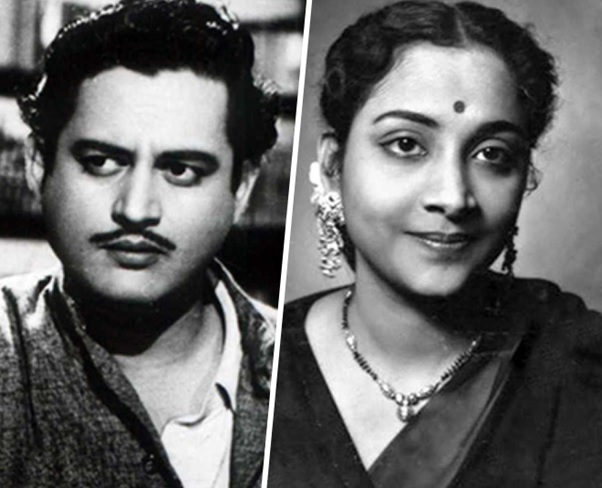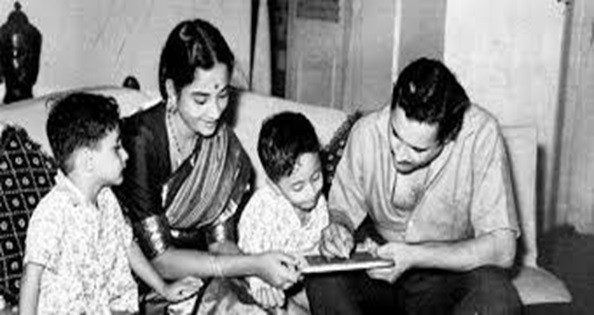
Tragedy of a Love Marriage
By Dr Asif Javed
Williamsport, PA
Anwar Maqsood was once asked what type of movies he liked. “There I have the collection of Dilip Kumar and Guru Dutt movies,” the veteran writer pointed to the shelf. Back in the 90’s, the Time Magazine published a list of fifty all-time great movies from all countries. The list included two movies from India, a Sita Jeet Ray movie, and Piyasa by Guru Dutt. Finding Guru Dutt in the elite company of Dilip and Sita Jeet Ray surprised quite a few.
Back in the early 1950s, Guru Dutt was a struggling actor in Bollywood while Gita Roy was a rising star of film music. Gita was from Bengal and Guru from the South. They met in Bombay, fell in love and, despite resistance from Gita’s family, got married.
Guru Dutt’s fledgling career eventually took off and he started playing the lead role in movies but soon moved in to direction. Dev Anand, who was a friend from their early days in Bombay, recognized Guru Dut’s talent: “He was brimming over with artistic creation and lava that has to explode.” As a director, he wanted to be different and original. For example, he introduced several innovations in the song picturizations. “He used songs in his movies as an extension of script rather than as random interval points. His signature style,” writes his biographer Yassar Usman, “was a song beginning without the introductory music.”
Guru Dutt’s star was on the rise but there was something odd about him: he had a temper and suffered from mood swings. Hidden behind the façade of a family man, and admired director, was a closely guarded secret - he suffered from depression. “He was all the time at war with his inner self, melancholy and withdrawn,” Dev Anand once remarked. Gita Roy was presumably not aware of this when they got married. Married life went on smoothly for a few years. But then the golden couple, the envy of so many, ran into problems.
So, what really created problems in their marriage? The short answer is: Wahida Rahman. Wahida Rahman was introduced in Bollywood by Guru Dutt. Her first role was in CID and she went on to become an integral part of Guru Dutt movies. It was not long before there were rumors of an affair between Guru Dutt and Wahida Rahman. Naturally, it led to a strain in Guru Dutt and Geeta Dutt’s marriage. “The first few years of our married life were happy, but things began getting messy the day Wahida stepped into the studio” Gita once said.
Wahida Rahman was not the only problem, however. “Guru and Gita were poles apart in their habits,” writes Yasser Usman. “While Guru Dutt was shy and would get irritated with parties or family functions, Gita was sociable and felt at home in the glitter of the film world. She organized regular get-togethers at her house and wanted Guru to participate. Guru hated it.”

The tragedy of Guru and Gita Dutt’s family did not end with their deaths. Both their sons suffered from depression. Having failed to reproduce their illustrious father’s success as movie makers, one of them committed suicide while the other died of alcoholism
Despite his struggle with depression, Guru Dutt continued his quest to make good movies. In a career span of just over a decade, he produced, directed and acted in at least three movies that have kept his name alive. He made some ‘formula movies’ too, just to earn a living. But it is with Piyaasa, Kaghez Ke Phool, and Sahib Bibi aur Ghulam that he needs to be remembered.
Guru Dutt was found dead on Oct 10, 1964. He was thirty-nine. Separated from Gita, he had spent the night alone in his apartment. A half full glass of alcohol and a bottle of sleeping pills lay on the side table. To this day, it is unclear whether it was an accidental overdose or suicide.
Remarkably, Guru Dutt’s aura has grown over the years, although he won no awards during his relatively brief career from 1953 to 1964. As a proof of his talent, his admirers - this scribe among them - point out to the celebrated trilogy: Sahib Bibi aur Ghulam, Piyaasa and Kaghaz Ke Phool.
Sahib Bibi aur Ghulam was the story of a neglected long-suffering wife of a decadent, alcoholic landlord of Bengal. Meena Kumari was chosen to play that role. And the tragedy Queen did play it to almost perfection. Meena Kumari, who had narrowly lost out playing Paro opposite Dilip Kumar in Bimal Roy’s classic Dev Daas, put her heart and soul into the role that some consider as good as the one in Pakeeza.
Kaghez Ke Phool was a project dear to Guru Dutt’s heart. Insiders knew that its story reflected his own life. They tried to dissuade him. “Do not make this movie,” SD Berman told him, “It is your own story.” Guru was not deterred and continued filming the story of a once successful movie director, who is in an unhappy marriage, and falls in love with the heroine. At the end, he loses everything: his wife, career and the woman he loved. He dies a broken forgotten man. The role of the director’s love interest was played by Wahida Rahman. Guru Dutt had high expectations of Kaghez KePhool. Unfortunately, it turned out to be a disaster at the box office. Devastated by the failure of his favorite movie, he wound up not using his name as director after that. Ironically, Kaghaz Ke Phool has lately become a cult classic and has been taught at several film schools. Unfortunately, its creator is not around to take satisfaction from that.
Before marriage, Gita Roy had been singing for top-notch music directors like SD Berman and OP Nayyar. She had the most original voice in film music, OP Nayar said once: “There was a unique quality to her singing. Give her a blatantly Westernized tune this moment and a complex classical composition the next, she would do equal justice to both with an ease of expression which a singer can only be born with…Gita Dutt was an asset to any music director.”
The turmoil in the marriage began to affect Gita’s music career. Preoccupied with her husband’s infidelity, a frustrated and disillusioned Gita began to miss her riaz, would be often late for rehearsals, and sometime missed the recording session altogether. As fate would have it, another young singer came to the attention of musicians. Like Gita, she too possessed a good voice. But she had something that Gita lacked: she was a consummate professional with a remarkable dedication to her craft. Having come from a family of musicians from Maharashtra, Lata Mangeshkar soon left Gita Dutt in the dust. Only belatedly did Gita realize the damage done to her career. “Nayer Sahib, aap to hameinbhool he gaye,” she once asked OP Nayer on the phone. But OP Nayar was firmly committed to Asha by then. And Lata, a once in a generation talent, had already become the favorite of elite musicians like Naushad, SD Berman, and Shankar Jai Kishan and was not to relinquish the number one spot. Lata was soon followed by her sister Asha who too soon made a niche for herself. Years later, OP Nayar was to admit: “Asha Bhosle sang all my songs with her heart and soul. However, Gita’s voice modulation was far better. It remains one of my greatest regrets that I phased out Gita due to my emotional involvement with Asha.”
Some of the wounds were self-inflicted: Gita and Guru had an understanding that she would be free to accept any song offers that came her way. But Guru later changed his mind and restricted her to sing for Guru Dutt movies only. This limited her to just one to two movies per year while her competitors, Lata and Asha, were free to sing for anyone. Her marital life in disarray and music career in the doldrums, Gita also developed depression and tried to commit suicide by slashing her wrists. She survived that, but a failed career and a strained marriage had taken their toll. She got addicted to alcohol and sleeping pills. She died of alcoholic liver cirrhosis in 1972 at forty-one. Thus ended the life of Gita Dutt. Given her talent, one can only speculate as to how far she might have gone.
Guru and Gita Dutt were among several showbiz celebrities who have succumbed to the menace of depression. This terrifying, and not uncommon condition has led to suicides by many others, including Robin Williams (2024), Heath Ledger (2008), and Charles Boyer (1978). Depression has not spared Noble Laureates either - Earnest Hemingway shot himself in 1961.
The tragedy of Guru and Gita Dutt’s family did not end with their deaths. Both their sons suffered from depression. Having failed to reproduce their illustrious father’s success as movie makers, one of them committed suicide while the other died of alcoholism. And it had all started when a young couple fell in love. Such are the uncertainties of love and life. Shakeel Badayuni’s ghazal, sung by incomparable Begum Akhtar, summarizes it best:
Ae-mohabat-tere-anjaam-pe-rona-aya
Jane-kiyun-aaj-tere-naam-pe-rona-aya
(The writer is a physician in Williamsport, PA, and may be reached at asifjaved@comcast.net)

